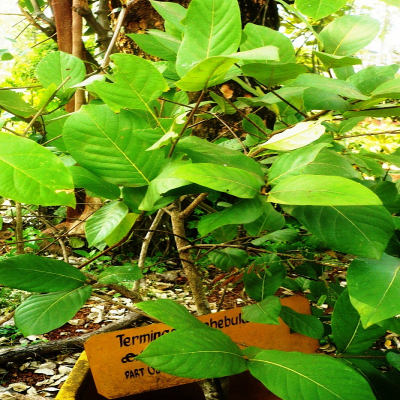Distribution and habitat: Found throughout India chiefly in deciduous forests, on dry slopes upto 900 m especially in Bengal, Tamil Nadu, West coast and Western Ghats. The plant is also reported in Sri Lanka, Nepal and Burma
Botany: It is a medium-sized deciduous tree with a cylindrical bole, rounded crown, spreading branches, dark brown bark and brownish-gray hardwood.
- Leaves: Simple, alternate or subopposite, ovate or elliptic ovate with short petioles bearing 2 glands below the blades.
- Flowers: Pale yellow or white in 4-10 cm long terminal spikes. Calyx tube hairy pale yellow and 5 lobed; no petals. Stamens 10, filaments subulate, anthers small; ovary inferior, 1-celled with 2-3 pendulous ovule.
- Fruit : Drupe, ovoid glossy, glabrous, faintly angled and yellow to orange brown in colour.
- Seeds : Hard and pale yellow
Properties: Antioxidant, Antispasmodic, hypoglycaemic, hepatoprotective
Chemical constituents:
- Kernel oil contains 6 fatty acids viz. palmitic, stearic, oleic, linoleic, arachidic and behenic acid.
- The fruits contain chebulinic acid, tannic acid, gallic acid, chebulin and tannin.
- Leaves contain terpenes and saponins.
- β-sitosterol is present in the bark
Uses:
- In allopathy it is used in astringent ointments.
- In unani system it is used as a blood purifier.
- The pulp of the fruit is given in piles, chronic diarrhoea, dysentery, costiveness, flatulence, asthma, urinary disorders, vomiting, hiccup, intestinal worms, ascites and enlarged spleen and liver.
- Powder of the fruit is used in chronic ulcers and wounds, carious teeth and bleeding ulceration of the gums.
- The bark is a good cardiac tonic.
- The fruit is valuable for its tannins and dyes.
- The wood is used for building purposes, agricultural implements, plywood and match box industries. It is also grown as a shade tree.
Formulations: Abhayarishta, Abhaya modak, Haritaki khand, Triphaladi churnam and Agastya rasayanam.
Young plants prefer shade while the matured plants tolerate light frost and drought. It grows well in hilly areas. This is propagated by seeds. Natural multiplication happens rarely due to the poor seeds germination. Seeds soaked in water for 48 hours before sowing in seedbeds which should be covered with straw after sowing. It is watered immediately. Usually it takes 3-5 months to germinate. It can be transferred to polybags at two-leaf stage. One-year-old seedlings are ready for transplanting. For transplanting, pits are made of 50cm cube at a spacing of 4m. Organic manure, added regularly, promotes growth. Irrigation is required during first year. Weeds should be removed regularly. This plant grows slowly. It fruits within 6-7 years. This is continued for many years. It is coppiced well. Fruits are collected immediately after falling down or covered with soil to protect it from pests. Fruits dried well in sun and used or stored. The hard seed coat is removed before sowing.
Agrotechnology
Soil and climate: Young plants prefer shade while matured plants tolerate light frost and drought. It grows well in hilly areas. Deep fertile forest soils are preferred though they can tolerate well-drained lateritic soils also.
Propagation: Seeds. seed have poor germination. Pre-soaking of seeds in water for 48 hours before sowing gives better germination. The hard seed coat is removed before sowing. The seedbeds should be covered with straw and watered immediately after sowing. It takes 3-5 months to germinate and they are transplanted into polythene bags at two-leaf stage and after one year to the main field.
Spacing: 8 m X 8m
Manures: The addition of organic manures promotes growth.
Pests and diseases: Leaf blight disease is common; initial symptoms start with minute spots on leaves which quickly coalesce to form bigger patches, which turn into blight and finally result in leaf-fall and the drying up of the plant. It can be controlled effectively by spraying 0.2% copper oxy chloride, whenever the disease is noticed.


